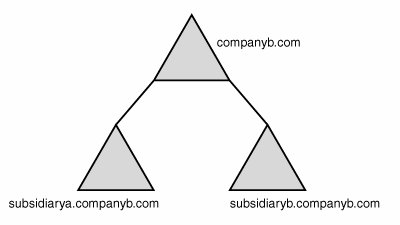Multiple Domain Model
| For various reasons, organizations may need to add more than one domain to their environment but preserve the functionality that is inherent in a single forest. When this occurs, the addition of one or multiple domains into the forest is warranted. Domain addition should not be taken lightly, however, and proper consideration must be given to the particular characteristics of multiple domain models. By default, two-way transitive trusts exist between subdomains and domains in Active Directory. Bear in mind, however, that this does not mean that resource access is automatically granted to members of other domains. A user in subdomain B is not automatically granted any rights in domain A; the rights need to be explicitly defined through the use of groups. Understanding this concept will help to determine the logistics of domain addition. When to Add Additional DomainsAs previously mentioned, it is advisable to begin your Windows Server 2003 Active Directory design with a single domain and then add domains only when absolutely necessary. Adding child domains to an existing domain structure may become necessary if the following traits exist within an infrastructure:
When contemplating additional domains, remember the mantra "Simplicity is best." However, if during the design process, the specific need arises to add domains, proper design is still warranted, or your environment will run the risk of looking like the type of messed-up NT domain structure that's best avoided. A Multiple Domain Real-World Design ExampleThe following example illustrates an organization that would have grounds to establish multiple domains. Company B is an engineering company based in York, Pennsylvania. Administration for all branch locations is currently centralized in the home office, and OUs and Group Policies are used for delegation of lower-level tasks. Recently, the company acquired two separate companies named Subsidiary A and Subsidiary B; each contains its own IT department and operates in separate geographical areas. Company B decided to implement Active Directory as part of a Windows Server 2003 implementation and wanted to include the two acquired companies into a single common forest. Because each acquired company possesses its own IT department and there are no immediate plans to consolidate those functions centrally, Company B decided to deploy an Active Directory structure with two subdomains for Subsidiary A and Subsidiary B, as shown in Figure 5.5. Figure 5.5. Active Directory with two subdomains. This design model allowed for a certain degree of administrative freedom with the newly acquired subsidiaries but also allowed for a common forest and schema to be used and kept the domains within the same DNS namespace. This design model has the particular advantage of being politically easier to implement than consolidation of existing domains. Branch offices and subsidiary companies can keep their own domain structure and security boundaries, and their IT teams can retain a greater deal of administrative autonomy. Be warned, however, that consolidation of NT domains into fewer domains is a key feature of Active Directory, so the addition of domains purely for political reasons adds complexity and potentially unnecessary infrastructure. It is therefore very important to consider the alternatives before deciding on this design model. |
EAN: 2147483647
Pages: 499
